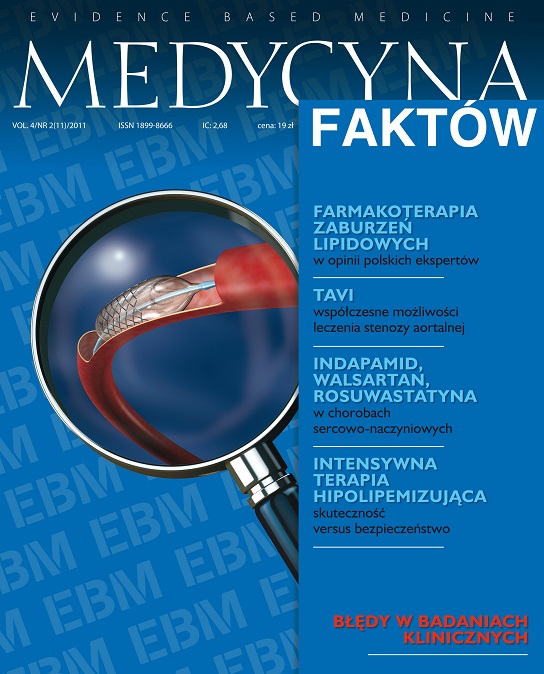Rosuwastatyna w leczeniu zaburzeń lipidowych Artykuł przeglądowy
##plugins.themes.bootstrap3.article.main##
Abstrakt
Statyny to najczęściej stosowana grupa leków w terapii zaburzeń lipidowych. Dowody na redukcję stężeń lipidów i poprawę rokowania pacjentów dzięki leczeniu statyną są silne i jednoznaczne. Rosuwastatyna to preparat o efekcie hipolipemizującym silniejszym od simwastatyny i atorwastatyny. Kolejne badania kliniczne przynoszą dowody na korzystne działanie rosuwastatyny zarówno w grupie pacjentów z rozpoznaną chorobą niedokrwienną serca lub jej ekwiwalentem, jak i w grupie chorych bez choroby układu krążenia, ale obciążonych zwiększonym ryzykiem sercowo-naczyniowym. Wykazywano również korzyść z leczenia rosuwastatyną w postaci regresji zmian miażdżycowych w tętnicach szyjnych i wieńcowych. W poniższym artykule podsumowano miejsce statyn w prewencji i terapii chorób układu krążenia oraz przedstawiono wybrane badania oceniające skuteczność i bezpieczeństwo leczenia rosuwastatyną.
##plugins.themes.bootstrap3.article.details##
Copyright © by Medical Education. All rights reserved.
Bibliografia
2. Hemingway H., McCallum A., Shipley M., Manderbacka K., Martikainen P., Keskimaki I.: Incidence and prognostic implications of stable angina pectoris among women and men. JAMA 2006; 295: 1404-1411.
3. Bassand J.P., Hamm C.W., Ardissino D. et al.: Guidelines for the diagnosis and treatment of non-ST-segment elevation acute coronary syndromes. Eur. Heart J. 2007; 28: 1598-1660.
4. Van de Werf F., Bax J., Betriu A. et al.: Management of acute myocardial infarction in patients presenting with persistent ST-segment elevation: the Task Force on the Management of ST-Segment Elevation Acute Myocardial Infarction of the European Society of Cardiology. Eur. Heart J. 2008; 29: 2909-2945.
5. Dickstein K., Cohen-Solal A., Filippatos G. et al.: ESC Guidelines for the diagnosis and treatment of acute and chronic heart failure 2008: the Task Force for the Diagnosis and Treatment of Acute and Chronic Heart Failure 2008 of the European Society of Cardiology. Developed in collaboration with the Heart Failure Association of the ESC (HFA) and endorsed by the European Society of Intensive Care Medicine (ESICM). Eur. Heart J. 2008; 29: 2388-2442.
6. Kjekshus J., Apetrei E., Barrios V. et al.: Rosuvastatin in older patients with systolic heart failure. N. Engl. J. Med. 2007; 357: 2248-2261.
7. Mancia G., De B.G., Dominiczak A. et al.: 2007 Guidelines for the management of arterial hypertension: The Task Force for the Management of Arterial Hypertension of the European Society of Hypertension (ESH) and of the European Society of Cardiology (ESC). Eur. Heart J. 2007; 28: 1462-1536.
8. Ryden L., Standl E., Bartnik M. et al.: Guidelines on diabetes, pre-diabetes, and cardiovascular diseases: executive summary. The Task Force on Diabetes and Cardiovascular Diseases of the European Society of Cardiology (ESC) and of the European Association for the Study of Diabetes (EASD). Eur. Heart J. 2007; 28: 88-136.
9. Pajak A., Wiercinska E., Polakowska M. et al.: Prevalence of dyslipidemia in men and women between the ages of 20-74 in Poland. Results of the WOBASZ program. Kardiol. Pol. 2005; 63: S620-S625.
10. Kjekshus J., Pedersen T.R.: Reducing the risk of coronary events: evidence from the Scandinavian Simvastatin Survival Study (4S). Am. J. Cardiol. 1995; 76: 64C-68C.
11. Stalenhoef A.F., Ballantyne C.M., Sarti C. et al.: A comparative study with rosuvastatin in subjects with metabolic syndrome: results of the COMETS study. Eur. Heart J. 2005; 26: 2664-2672.
12. Berne C., Siewert-Delle A.: Comparison of rosuvastatin and atorvastatin for lipid lowering in patients with type 2 diabetes mellitus: results from the URANUS study. Cardiovasc. Diabetol. 2005; 4: 7.
13. Jones P.H., Davidson M.H., Stein E.A. et al.: Comparison of the efficacy and safety of rosuvastatin versus atorvastatin, simvastatin, and pravastatin across doses (STELLAR* Trial). Am. J. Cardiol. 2003; 92: 152-160.
14. Jones P.H., Hunninghake D.B., Ferdinand K.C. et al.: Effects of rosuvastatin versus atorvastatin, simvastatin, and pravastatin on non-high-density lipoprotein cholesterol, apolipoproteins, and lipid ratios in patients with hypercholesterolemia: additional results from the STELLAR trial. Clin. Ther. 2004; 26: 1388-1399.
15. Leiter L.A., Rosenson R.S., Stein E. et al.: Efficacy and safety of rosuvastatin 40 mg versus atorvastatin 80 mg in high-risk patients with hypercholesterolemia: results of the POLARIS study. Atherosclerosis 2007; 194: e154-e164.
16. Kendrach M.G., Kelly-Freeman M.: Approximate equivalent rosuvastatin doses for temporary statin interchange programs. Ann. Pharmacother. 2004; 38: 1286-1292.
17. Ridker P.M., Danielson E., Fonseca F.A. et al.: Rosuvastatin to prevent vascular events in men and women with elevated C-reactive protein. N. Engl. J. Med. 2008; 359: 2195-2207.
18. Glynn R.J., Danielson E., Fonseca F.A. et al.: A randomized trial of rosuvastatin in the prevention of venous thromboembolism. N. Engl. J. Med. 2009; 360: 1851-1861.
19. AstraZeneca. US FDA approves new indication for Crestor (rosuvastatin calcium). 9 lutego, 2010.
20. Crouse J.R. III, Raichlen J.S., Riley W.A. et al.: Effect of rosuvastatin on progression of carotid intima-media thickness in low-risk individuals with subclinical atherosclerosis: the METEOR Trial. JAMA 2007; 297: 1344-1353.
21. Clearfield M.B., Amerena J., Bassand J.P. et al.: Comparison of the efficacy and safety of rosuvastatin 10 mg and atorvastatin 20 mg in highrisk patients with hypercholesterolemia – Prospective study to evaluate the Use of Low doses of the Statins Atorvastatin and Rosuvastatin (PULSAR). Trials 2006; 7: 35.
22. Shepherd J., Hunninghake D.B., Stein E.A. et al.: Safety of rosuvastatin. Am. J. Cardiol. 2004; 94: 882-888.
23. ChPL. Rosuwastatyna [online].
